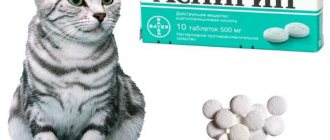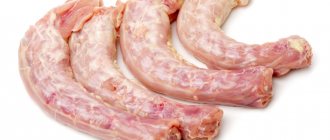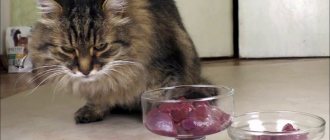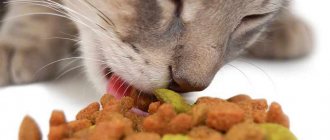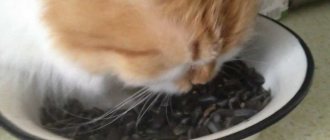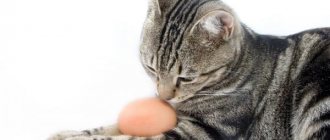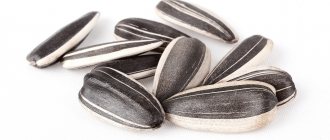Having decided to feed your cat homemade natural food, you need to clearly understand all the responsibility that falls on the owner’s shoulders for the cat’s health. Many people immediately wonder if cats can have rice, buckwheat and other grains. Which meat is best and in what form to eat vegetables.
In ready-made food, everything is simple, you buy it, feed it, and the manufacturer takes care of the composition. But there are also some nuances, the first of which is price. But many simply believe that homemade food for a cat will be healthier and it is difficult to convince them of this, and is it necessary to do this?
© shutterstock
Benefits of cereals
Various cereals must be included in a cat’s diet. As for rice, it contains a large amount of useful vitamins and minerals; it is a source of magnesium and phosphorus, silicon and zinc, as well as many useful vitamins. But despite all its benefits, it is impossible to give a cat rice in large quantities, since it has a fastening property that can cause constipation in a cat.
Rice porridge will serve as an excellent source of carbohydrates for the cat's body. She needs them in small quantities, much less than protein. Thanks to a sufficient supply of carbohydrates, the cat always remains active and cheerful, she plays, runs and has fun.
In addition to rice, a cat's diet should include the following cereals::
- buckwheat;
- corn;
- oatmeal;
- wheat;
- artek
Is it possible to give?
If the fluffy eats such a product, then he will not have problems with his teeth.
When creating a diet for both a kitten and an adult cat, it is important to include fermented milk products. The trace elements and nutrients they contain will ensure the normal growth and development of your pet. Thanks to the large amount of proteins, calcium and fluoride, the condition of the pet’s skeletal system will be fine. If you constantly give your kitten cottage cheese, muscle tissue will develop faster, and its teeth and claws will grow strong. As a rule, cats fed dairy products have thick, shiny fur and no problems with bowel movements.
Cottage cheese for kittens is the healthiest of fermented milk products, so it can not only be given, but also necessary.
How to choose the right menu
Since cats are predatory animals, they need to be fed accordingly. More than half of their diet should be meat. It could be turkey, chicken, beef. It is better to boil and twist the meat. Raw meat should not be fed to avoid the possibility of helminth infection. If you think that your cat is still a predator and should receive raw meat in its diet, then it can and should be frozen before consumption. Then defrost and, already defrosted, add it to your pussy’s menu.
So, as a percentage, meat will be a little more than 50%. Vegetables account for 20 to 30% of a cat's diet; they can be called a very healthy product, since all vegetables contain large amounts of vitamins. Porridge will make up only 10% of the total diet. From this we understand that you can feed your cat rice, but in small quantities. Alternating different types of cereals with each other. For example, rice can be given once a week.
It is also important to remember about vitamins. From time to time you need to give your cat vitamins to keep her body in good shape. When choosing a drug, it is better to consult a veterinarian.
© shutterstock
Rules for feeding your pet cottage cheese
In order for your cat to get the maximum benefit from eating cottage cheese, you need to follow a few simple rules. First of all, choose your cottage cheese carefully. It must have a normal expiration date and not be spoiled. It is forbidden to give sour cottage cheese to your pets. If you are not sure about the quality of a store-bought product, take a homemade one, you can’t go wrong.
When choosing, you need to pay attention to what exactly is in the package. It should be cottage cheese, not a curd product or sweet curd. These products are harmful to cats because they contain fragrances, various chemical additives and sugar. Everything sweet is a home for the cat's body.
You should not buy low-fat cottage cheese, as it will not be beneficial. Recommended fat content for cats is 9%.
To prevent an allergic reaction, it is recommended to start with minimal doses and monitor the pet’s condition. If diarrhea or poor health occurs, this product should be removed from the diet.
© shutterstock
To fully provide your pet's body with calcium, it is enough to give the kitten cottage cheese 3-4 times a week . This will cover all the needs of a growing organism. For adult cats, the number of cottage cheese feedings is reduced to 1-2 times a week.
You can add egg yolk to the cottage cheese. This will make it a real treat for your cat. Protein cannot be added. You can give cottage cheese with sour cream. But then the product will turn out fattier and it is recommended to reduce its quantity.
Too fatty cottage cheese will lead to serious consequences in the form of chronic liver diseases and obesity.
Who shouldn't have rice?
For healthy cats and kittens, without any pathologies, rice can and even should be included in the diet. However, not all cats are in excellent health. And here the owner must decide which products will be included in the cat’s menu and which ones will be excluded.
Feeding rice porridge is prohibited for cats suffering from constipation, as rice will only make it worse.
It is not recommended to give rice porridge in large quantities to small kittens, since their digestive system is not yet fully formed. But rice is well absorbed by the body and you need to look at the situation. If a kitten goes to the toilet normally after rice porridge, then it can be introduced into the diet more than once a week.
This product is also recommended for pregnant cats due to its good digestibility by the cat’s body.
Benefits and harms
A balanced diet for kittens must include cottage cheese. This product has the following beneficial properties:
- normalizes intestinal function;
- enriches with vitamins and large amounts of protein;
- easily absorbed by the body;
- helps strengthen bones and teeth;
- has a beneficial effect on wool growth and quality.
However, along with the benefits, cottage cheese can also cause harm to the kitten. Some pets experience an allergic reaction, with the baby becoming weak, rashes and itching of the skin, and discharge from the nose and eyes. In addition, the body may become intolerant of the product, resulting in diarrhea and vomiting. With high fat content, cottage cheese puts an increased load on the liver, which has a detrimental effect on the overall health of the animal.
Method of preparation and serving size
Boil the delicacy in water without salt and spices. Shrimp are sensitive to their environment. Before heat treatment, the digestive tract is cleaned (it is unclear what they ate during life). To do this, the body is cut lengthwise with a knife. It turns out something like a “butterfly”. Next, you need to rinse well several times. And only after that throw it into the pan. Boiled-frozen ones can simply be defrosted in hot water. Otherwise they will lose the benefit.
The serving size should be small to avoid overeating. After all, cats cannot always control the process of satiation. Especially if they liked the food. For representatives of small breeds, one small shrimp or half a large one is enough. Older individuals can be given one large one. Pregnant individuals, as a rule, enjoy eating seafood. Valuable substances are useful not only for the mother, but also for the future offspring. The main thing is not to follow the lead of the “pot-bellied” and not to give too much volume.
Well, very tasty... I want more
The hunting instinct and pleasant aroma can prompt the cat to jump on the table in search of “yummy food”. Therefore, be sure to ensure that your dinner does not fall prey to the purr. Excessive consumption can lead to problems with the digestive tract.
Restrictions
If an animal constantly eats such a product, this can lead to the formation of tartar.
When feeding cats sour cream, you should follow the norm. All fermented milk products have a soft consistency. Therefore, your pet does not need to chew this food. Frequent or constant consumption of such food leads to disturbances in the chewing functions of the jaw and the appearance of tartar. As a result, the cat may become lazy and stop eating solid food.
Some owners prefer to feed their pets prepared food. In this case, dairy products, including sour cream, cannot be introduced into the diet. This can harm the animal, since in such food all components are balanced. The amount of vitamins, minerals and nutrients is carefully calculated. Violation of these proportions, when the cat has also eaten sour cream, threatens with indigestion and stool problems.
Persian, Angora and British cats should not be given sour cream, even if they eat it with pleasure. Veterinarians claim that their delicate bodies do not cope well with this product. Diarrhea occurs and your health deteriorates greatly. It is better to replace sour cream with low-fat cottage cheese or yogurt. The one-time dose is 30 g. You can give it to your cat once a week, even if he actively and happily eats the treat.
Mistakes in feeding your pet
Even experienced breeders and veterinarians have not found a common opinion on the topic of the dangers of shrimp in the diet of pets. Therefore, the owners are confused in their decisions. But we can say with confidence that there will be no benefit from such nutrition. In order to understand the correctness of the choice, it is necessary to clarify what breeders are definitely doing wrong in relation to their pets:
- You can't give a cat everything it wants on demand. If you want to pamper an animal, you can poison it.
- Heavy feeding is much worse than mild malnutrition. Obesity in a cat is quite difficult.
- You should not think that if a pet actively asks for something, it means that it feels a lack of certain vitamins in the body.
- There should be no variety in the menu of furry friends. A cat is not a gourmet, as commercials try to instill. She easily gets used to a certain correct diet.
You can often hear the opinion of “Old Believers” that cats in villages used to eat everything, but they were healthy and lived long. It is not difficult to guess that village meat and milk did not contain preservatives. The pets grew up free-range; they had access to the necessary herbs and organic products. Now you should carefully monitor your diet.
In addition, modern pets have long forgotten how to choose the “right” food on their own. Unfortunately, especially purebred pets are susceptible to various diseases. Basically, such cats are a product of selective breeding. From their ancestors they took not only positive qualities, but also a whole bunch of predispositions to genetic diseases. Is it worth risking your pet's health?
Why are shrimp good for cats?
Shrimp are a valuable source of:
- proteins - they contain 30% more proteins than beef;
- essential polyunsaturated fats – Omega-3 (540 mg) and Omega-6 (28 mg);
- vitamins – A, group B (B1, B2, B4, B5, B6, B9, B12), E and PP;
- minerals - a lot of phosphorus, sodium, selenium, a little less copper, iron, magnesium, potassium, calcium, manganese, etc.;
- iodine - shrimp contains 110 mcg per 100 g of krill - more than pink salmon and salmon.
The benefits of shrimp meat. Shrimp is a low-calorie product and when introduced into a cat’s diet, the risk of obesity is reduced. In addition, she will have:
- beautiful durable fur and strong claws;
- clean blood vessels, since shrimp eliminate “bad” cholesterol;
- high immunity;
- strong nervous system and stress resistance.
Scientists have found that shrimp improve thyroid function and even reduce the risk of cancer.
Industrial rations containing shrimp. Knowing the benefits of shrimp meat for the body of cats, many premium food manufacturers introduce them into their products, for example:
- Tuna Prawns wet food from Schesir;
- Shrimp and Chicken Dry Food with Shrimp and Turkey from Home Food;
- canned Shiny Cat from Gimpet with tuna and shrimp;
- Butcher's Delicious Dinner mousse with salmon and shrimp;
- pate Vom Feinsten from Animonda;
- Grain Free by Optimal.
The best combination is considered to be poultry with shrimp and vegetables. This way the cat receives the maximum of nutrients in an easily digestible form.
Dairy and fermented milk products in the diet of cats
Nutritionists, veterinarians and cat owners are still hotly arguing about whether cats need such food. There is still no consensus on this matter. But there are still several important points that many experts agree on:
- Kittens up to six months old must be given dairy products. This food is extremely necessary for a growing body.
- As an animal gets older, its digestive tract begins to absorb lactose less well, so it is better to include fermented milk products in a cat's diet.
- Regardless of the type of product, it must be fresh, natural, and free of sugar and artificial flavorings and preservatives.
- The owner should pay attention to the fat content of fermented milk; this figure should not exceed 9%.
Selection of fermented milk products. In order for your pet’s menu to be complete, you need to compose it correctly, selecting suitable fermented milk products, taking into account a number of nuances:
- Kefir - before serving, it must stand for at least 3 days so that the alcohol substances disappear from it (read more about whether cats can have kefir).
- Cream is a high-fat product and is therefore not suitable for feeding cats. Their consumption threatens the pet with digestive upset, and frequent eating will increase the load on the liver.
- Milk remains in the cat’s diet if its body copes well with the absorption of lactose, but it is recommended to give it little by little and infrequently (read more about whether cats can have milk).
- Sour cream contains too much fat, which will lead to obesity in your pet, as well as digestive problems. Occasionally you can pamper your pet with a spoonful of 10% fat sour cream.
- Curdled milk, fermented baked milk, Varenets, yogurt are suitable for feeding mustachioed tabbys. Only if we are talking about natural, fresh products.
- Cottage cheese can definitely be given to cats, twice a week, without sweetening.
When creating a menu for a cat, it is enough to add fermented milk products 2-3 times a week.
And when selecting them, you need to monitor the fat content, ingredients and expiration date.

